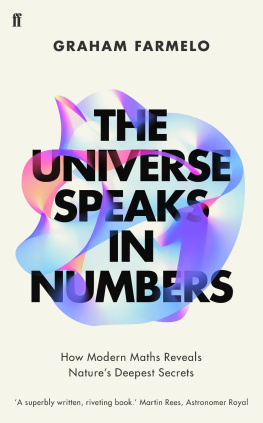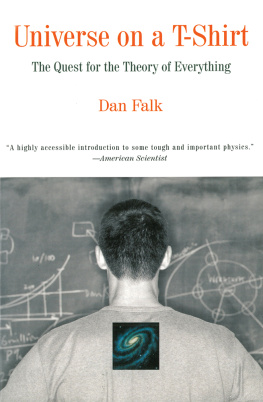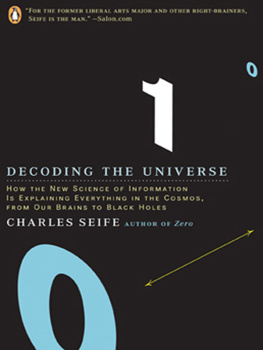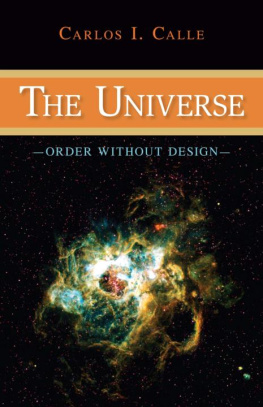Crisply written, entertaining and extraordinarily well informed. The most popular and elegant theories of what makes the cosmos tick are becoming harder even impossible to test directly, but Farmelo argues in this tour de force that theyre still taking us deep into the mathematical heart of reality. Roger Highfield, Director of External Affairs at the Science Museum, London
Farmelo expertly narrates the history of the dynamic dance between mathematics and theoretical physics, from Newton to Einstein to string theory and beyond. This book will be a must-read for anyone interested in either subjects history or present for many years ahead. Jacob Bourjaily, Associate Professor of Physics, Niels Bohr International Academy, Copenhagen University
This fascinating, splendidly readable, extensively researched and remarkably up-to-date book takes readers from the days of Newton to the forefront of modern theoretical physics, and shows how current research has reshaped the fields of physics and mathematics to the enrichment of both. Jeremy Gray, Emeritus Professor at the Open University and an Honorary Professor in the Mathematics Institute of the University of Warwick
The harmony of the world is made manifest in Form and Number, and the heart and soul and all the poetry of Natural Philosophy are embodied in the concept of mathematical beauty.
I hold it to be true that pure thought can grasp reality, as the Ancients dreamed.
Albert Einstein, On the Method of Theoretical Physics, 1933
Einstein is completely cuckoo. That was how the cocky young Robert Oppenheimer described the worlds most famous scientist in early 1935, after visiting him in Princeton. Einstein had been trying for a decade to develop an ambitious new theory in ways that demonstrated, in the view of Oppenheimer and others, that the sage of Princeton had lost the plot. Einstein was virtually ignoring advances made in understanding matter on the smallest scale, using quantum theory. He was seeking an ambitious new theory, not in response to puzzling experimental discoveries, but as an intellectual exercise using only his imagination, underpinned by mathematics. Although this approach was unpopular among his peers, he was pioneering a method similar to what some of his most distinguished successors are now using successfully at the frontiers of research.
Oppenheimer and many other physicists at that time can hardly be blamed for believing that Einsteins mathematical approach was doomed: for one thing, it seemed to contradict one of the principal lessons of the past 250 years of scientific research, namely that it is unwise to try to understand the workings of nature using pure thought, as Plato and other thinkers had believed. The conventional wisdom was that physicists should listen attentively to what the universe tells them about their theories, through the results of observations and experiments done in the real world. In that way, theorists can avoid deluding themselves into believing they know more about nature than they do.
Einstein knew what he was doing, of course. From the early 1920s, he often commented that experience had taught him that a mathematical strategy was the best hope of making progress in his principal aim: to discover the most fundamental laws of nature. He told the young student Esther Salaman in 1925, I want to know how God created this world. Im not interested in this or that phenomenon, in the [properties] of this or that element. I want to know His thoughts, the rest are details.
Mathematics has furnished an incomparably precise way of expressing this underlying order. Physicists and their predecessors have been able to discover universal laws set out in mathematical language that apply not only here and now on Earth but to everything everywhere, from the beginning of time to the furthest future. Theorists, including Einstein, who pursue this programme may be accused quite reasonably of overweening hubris, though not of a lack of ambition.
The potential of mathematics to help discover new laws of nature became Einsteins obsession. He first set out his mathematical approach to physics research in the spring of 1933, when he delivered a special lecture to a public audience in Oxford. Speaking quietly and confidently, he urged theoreticians not to try to discover fundamental laws simply by responding to new experimental findings the orthodox method but to take their inspiration from mathematics. This approach was so radical that it probably startled the physicists in his audience, though understandably no one dared to contradict him. He told them that he was practising what he was preaching, using a mathematical approach to combine his theory of gravity with the theory of electricity and magnetism. That goal could be achieved, he believed, by trying to predict its mathematical structure the mathematics of the two theories were the most potent clues to a theory that unified them.
As Einstein well knew, a mathematical strategy of this type would not work in most other scientific disciplines, because their theories are usually not framed in mathematical language. When Charles Darwin set out his theory of evolution by natural selection, for example, he used no mathematics at all. Similarly, in the first description of the theory of continental drift, Alfred Wegener used only words. One potential shortcoming of such theories is that words can be treacherous vague and subject to misinterpretation whereas mathematical concepts are precise, well defined and amenable to logical and creative development. Einstein believed that these qualities were a boon to theoretical physicists, who should take full advantage of them. Few of his colleagues agreed even his most ardent admirers scoffed. His acid-tongued friend Wolfgang Pauli went so far as to accuse him of giving up physics: I should congratulate you (or should I say send condolences?) that you have switched to pure mathematics. I will not provoke you to contradict me, in order not to delay the death of [your current] theory. After he died in 1955, the consensus among leading physicists was that the abject failure of his approach had vindicated his critics, but this judgement has proved premature.
Although Einstein was wrong to gloss over advances in theories of matter at the subatomic level, he was in one respect more far-sighted than his many detractors. In the mid-1970s, twenty years after he died, several prominent physicists were following in his footsteps, trying to use pure thought bolstered by mathematics to build on well-established but flawed theories. At that time, I was a greenhorn graduate student, wary of this cerebral strategy and pretty much convinced that it was perverse and heading nowhere. It seemed obvious to me that the best way forward for theorists was to be guided by experimental findings. That was the orthodox method, and it had worked a treat for the theorists who developed the modern theory of subatomic forces. Later known as the Standard Model of particle physics, it was a thing of wonder: based on only a few simple principles, it quickly superseded all previous attempts to describe the behaviour of subatomic particles. It accounted handsomely for the inner workings of every atom. What I did not fully appreciate at the time was how fortunate I was to be sitting in the back row of the stalls, watching an epic contemporary drama unfold.
During those years, I remember attending dozens of seminars about exotic new theories that looked impressive but agreed only roughly with experiments. Yet their champions were obviously confident that they were on to something, partly because the theories featured interesting new mathematics. To me, this seemed a peculiar way of researching physics I thought it much better to listen to what nature was telling us, not least because it never lies.







